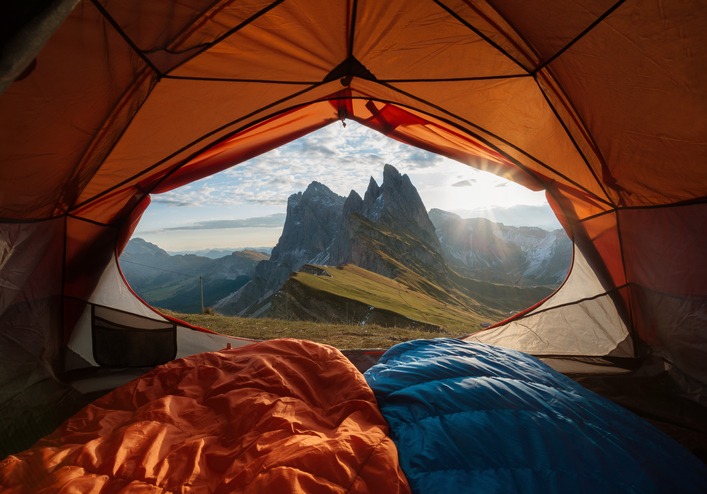With so many camping accessories to choose from, getting set up on a camping adventure with the right equipment is a bit of work. Luckily, you can teach yourself how to choose by looking at an experienced camo hiking and camping guide’s things they enjoy packing.
What should be in a camping tent?
When it comes to camping, your tent is your home away from home. So, what should be in a camping tent? Here are some essential items:
- A rain fly: This will help keep you dry if it rains while you’re camping.
- A tarp: A tarp can be used for a variety of things, including as a groundsheet or to create a makeshift shelter.
- Poles: You’ll need poles to set up your tent.
- Stakes: Stakes are used to secure your tent to the ground.
- Guy lines: Guy lines are used to stabilize your tent and keep it from blowing away in the wind.
- A footprint: A footprint helps protect the bottom of your tent from wear and tear.
Hiking Gear You Need When Camping
When it comes to hiking and camping, having the right gear is essential. From a comfortable pair of hiking boots to a reliable tent, there are a few key items that you’ll need to make sure you have before hitting the trails.
Hiking Boots: A good pair of hiking boots is one of the most important pieces of gear for any hiker. For example, if you want to climb Mount Kenya – the second highest peak in Africa after Kilimanjaro – the rugged terrain and varying weather conditions on such treks necessitate boots that offer ample support, stability, and protection for your feet. Make sure to find a pair that fits well and provides plenty of support and traction.
Tent: A camping tent from nz is another must-have for any hiker or camper. When choosing a tent, be sure to pick one that’s large enough to comfortably accommodate you and your gear.
Sleeping Bag: A warm and comfortable sleeping bag is essential for any camper. Be sure to choose one that’s designed for the season you’ll be camping in.
Camping Stove: If you plan on doing any cooking while camping, be sure to bring along a portable stove. There are many different models available, so be sure to choose one that best suits your needs.
These are just a few of the essential items you’ll need when hiking and camping. Be sure to pack everything you need before heading out into the great outdoors!
A Checklist for Our Hiking/Camping Needs
Before setting out on a hike or camping trip, it’s important to make sure you have all the gear and supplies you’ll need. Use this checklist to ensure you don’t forget anything essential:
- Tent
- Sleeping bag
- Pillow
- Hiking boots
- Clothes for all weather conditions
- Backpack
- Food and water
- First aid kit
- Map
The Ability to Cook on the Trail
Whether you are hiking for a day or camping for weeks, being able to cook on the trail is an important skill. Here are some tips for cooking on the trail:
- Choose the right stove: There are many different types of stoves available, so choose one that will best suit your needs. If you plan on doing a lot of cooking, choose a stove with multiple burners. If you just need to boil water, a single-burner stove will suffice.
- Pack the right food: Choose foods that are lightweight and easy to cook. Freeze-dried meals are a great option because they just require boiling water. Pack plenty of snacks as well, like energy bars and dried fruit.
- Be prepared: Make sure you know how to use your stove before you head out on the trail. Practice setting it up and lighting it at home so you can be sure everything will work when you need it to.
Trekking Poles
Trekking poles are an essential piece of equipment for any hiker or camper. They provide stability on uneven terrain, help relieve pressure on your joints, and can be used to set up your tent or tarp. There are many different types and brands of trekking poles available, so it’s important to do your research before making a purchase. Here are a few things to keep in mind when choosing trekking poles:
- Material: Trekking poles are usually made from either aluminum or carbon fiber. Aluminum is the more affordable option, but carbon fiber is lighter and stronger.
- Length: Trekking poles come in a variety of lengths, so it’s important to choose the right size for your height. Poles that are too short will be uncomfortable to use, and those that are too long will be difficult to control.
- Weight: The weight of your trekking poles is also important to consider. Lighter poles are easier to carry on long hikes, but heavier poles offer more stability.
- Grip: The grip is another important factor to consider when choosing trekking poles. Some grips are cushioned for comfort, while others are textured for better grip in wet or slippery conditions.
- Tips: Most trekking poles come with interchangeable tips that can be swapped out depending on the terrain you’ll be hiking on. Make sure to choose a pole with tips that will suit your needs.
Wet Weather Gear and Footwear
In order to stay comfortable and dry while hiking or camping in wet weather, it is important to have the proper gear and footwear. Wet weather gear includes items such as rain jackets, pants, and boots. Footwear for wet weather should be waterproof and provide good traction.
